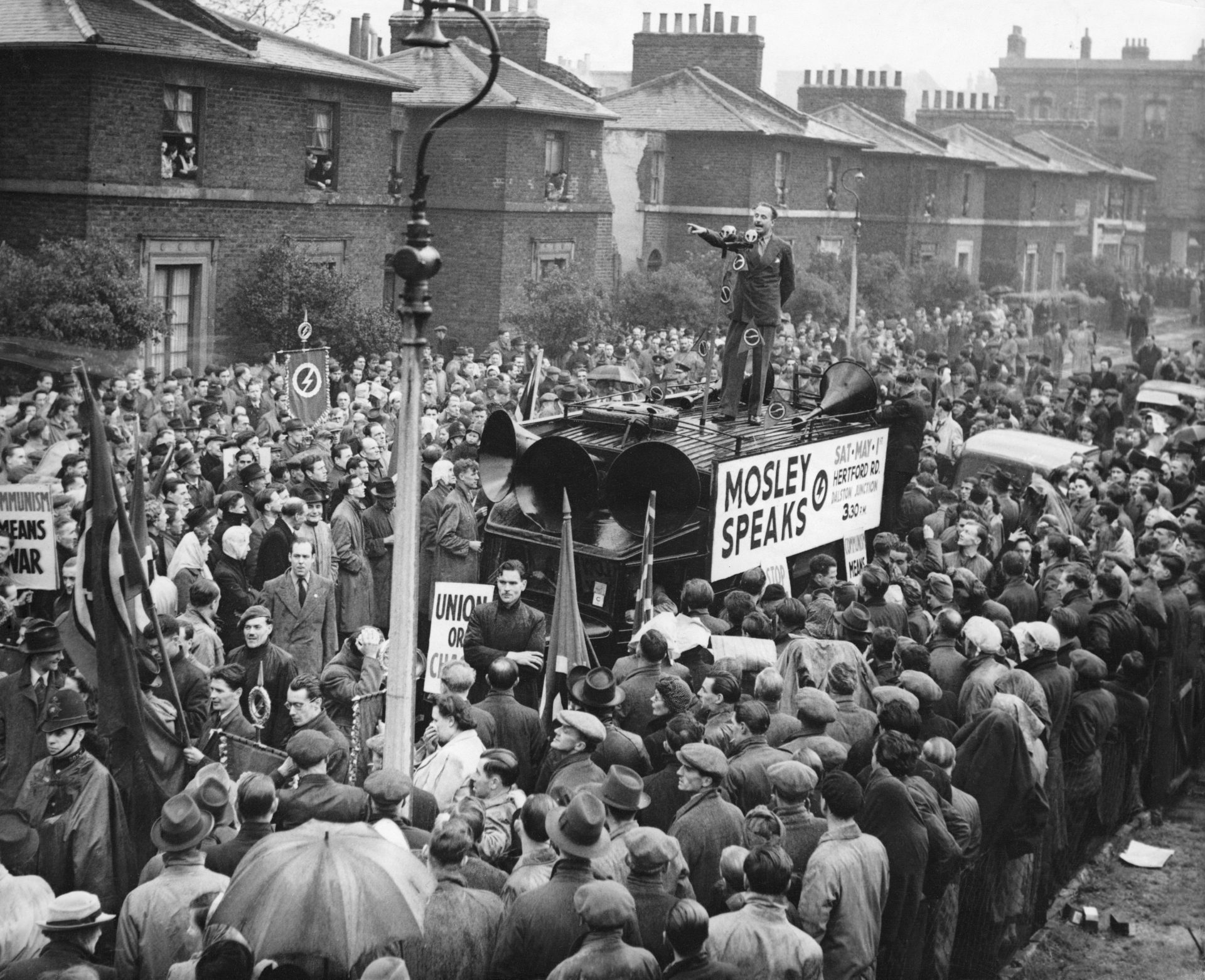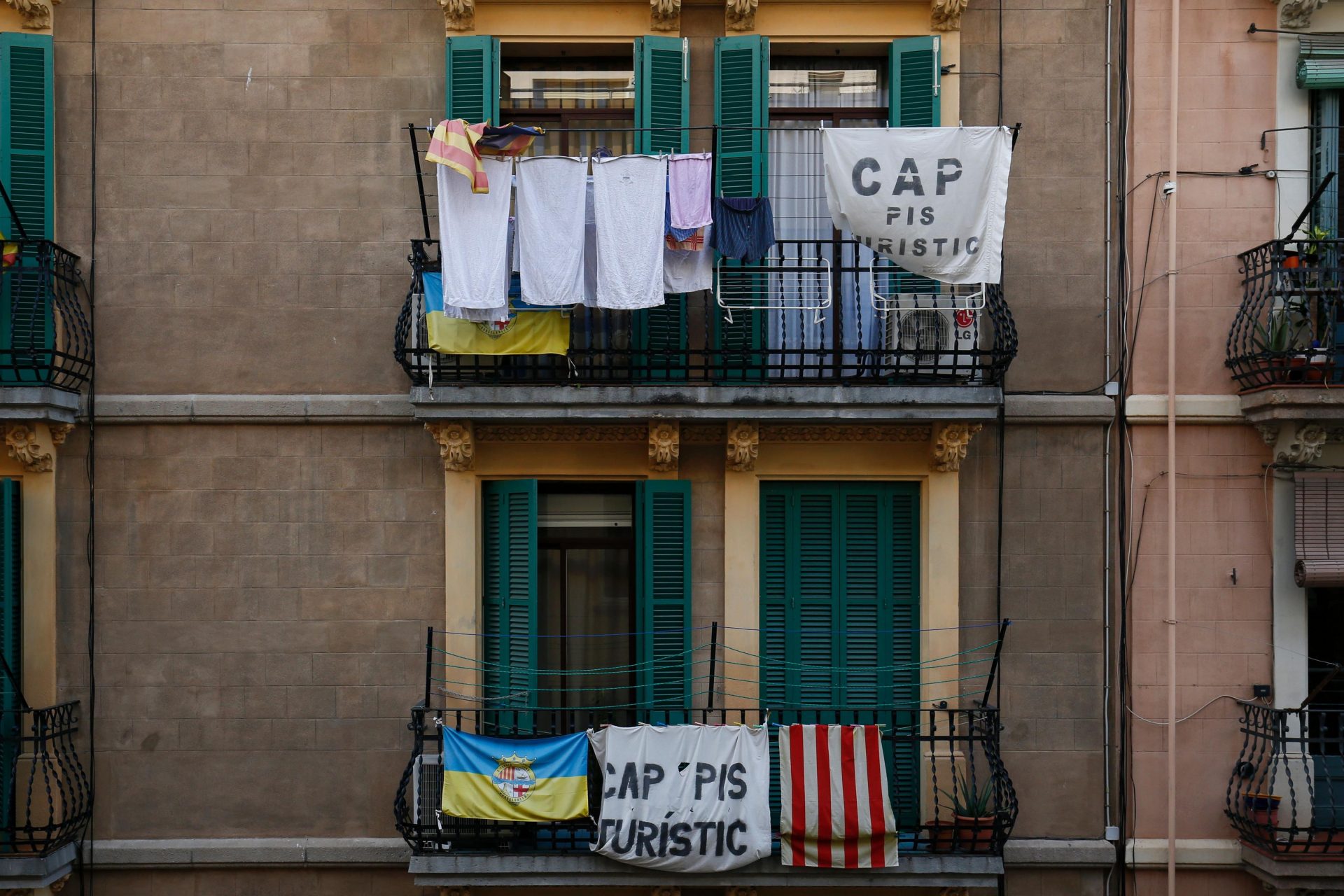It’s 1948 and a veteran political figure is calling for a united Europe following the horrors of the Second World War.
This high-profile politician went further than even the most ardent of modern Europhiles, advocating something far beyond a federal Europe and calling instead for full integration between states.
Yet this visionary wasn’t Winston Churchill, who famously supported the idea of a United States of Europe. And it certainly wasn’t the Eurosceptic prime minister Clement Attlee. Rather, it was Britain’s most famous fascist, Oswald Mosley.
While idealists such as the French statesman Robert Schuman were developing the ideas that would come to form the European Union from the ruins left from nationalism – and Hitler’s rather crude attempts to create his own united Europe – Mosley was spearheading a rival movement to integrate the continent into a single, pan-national political entity.
His status as an avowed Europhile might surprise many from the vantage point of 2021, when Eurosceptism tends to be seen (though not exclusively) as a right-wing position. Certainly, the modern Far Right is avowedly Eurosceptic. The BNP, Britain First and other extremist organisations all supported Brexit. But that only goes to show what a dramatic journey Britain’s Far Right has taken since its post-war pro-Europeanism.
At the end of the war, Mosley, the former leader of the British Union of Fascists, was a diminished figure.
In 1940, shortly after the fall of France and Churchill’s arrival in Downing Street, Mosley – who was then calling for Britain to accept Hitler’s offer of peace – was interned under Defence Regulation 18B.
For the next few years the former Labour MP and chancellor of the Duchy of Lancaster lived in a house in the grounds of Holloway Prison. Even when he was released on the grounds of ill health in 1943 the BUF had been banned and Mosley was under house arrest. He wasn’t finished with the Far Right, however.
Mosley began to outline his pan-European, post-war vision in My Answer (1946) and The Alternative (1947), where he outlined his idea of “Europe a nation”, arguing for a united continent – integrated into a single political entity – as a counter-balance against America and the Soviet Union.
Mosley had decided that pre-war fascist nationalism had been too limited in scope and in the post-war world, Europe needed to come together as one in a single supranational state. He was calling for direct elections to a “European Assembly” more than 30 years before the European parliament introduced them.
He saw a united Europe as an inevitability in his linear view of British history: Britain itself had united into one nation and now it was Britain’s destiny to unite the entire continent.
Despite his calls for a single European state, Mosley accepted that some form of national and local governments needed to continue for the sake of independent identities.
However, in a three-tier governmental system they would be subservient to the European government. A strong executive would exist which could be accepted or rejected through referendums, with an independent judiciary on hand to appoint replacements in the event of rejection.
Unsurprisingly, Mosley’s vision of a united Europe still dripped with fascist hatreds. According to the former BUF leader, the United Nations was part of a Jewish plot to undermine nationalism and he advocated expelling the entire Jewish population of Europe to Palestine.
Furthermore, in this fascist Europe not only would colonialism in Africa be maintained but also the system of racial segregation introduced by the National Party in South Africa in 1948 would be implemented across the whole continent.
Mosley used terms such as “European Socialism” to describe this society based upon a form of self-sufficient autarchy with price and income controls. However, in practice this was a form of elitist fascist corporatism inspired by the example of Mussolini in Italy, Salazar in Portugal and Dollfuss in Austria.
Elections would be held with an “occupation-based” franchise. Effectively this would mean the end of multi-party democracy with electors voting for representatives based on their occupation, rather than their geographical location. So, miners would vote for mining-based candidates, agricultural workers for agricultural candidates and health workers for doctors and nurses.
Mosley saw this as an opportunity to create an administration of experts who would be better equipped to provide good government. Businesses would also be given relative freedom while workers would be grouped in organisations known as “labour charters”, another policy borrowed from Il Duce’s Italy.
Indeed, plenty of Mosley’s post-war pan-Europeanism had its roots before the conflict. As early as 1936 he had written, in an essay entitled The World Alternative: “We must return to the fundamental concept of European union which animated the war generation of 1918.”
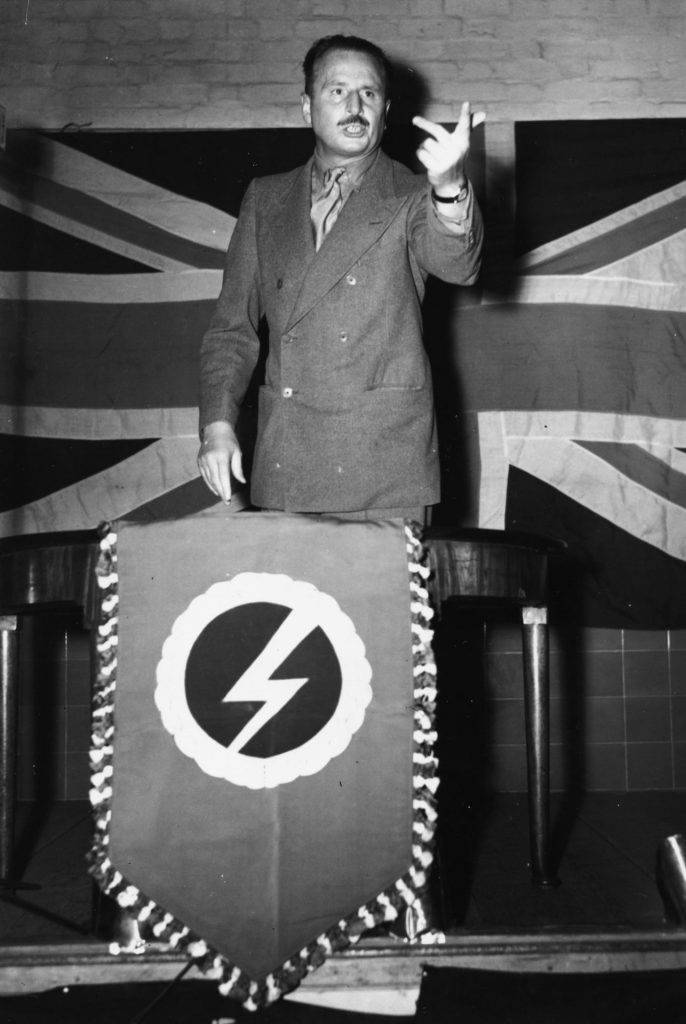
Two years later, in Tomorrow We Live, he declared that BUF policy was in favour of a “united Europe” and a “New Europe”.
Of course, the fascism of the 1930s had ended with another attempt to create a “united Europe”, under Hitler’s rule. And, as defeat loomed, some Nazis did toy with the idea of pan-Europeanism, rather than simple national dominance by the German Reich.
For instance, the Waffen SS indoctrinated their recruits, 50% of whom were non-German, with a mix of anti-communism, anti-Semitism and pan-Europeanism, with slogans proclaiming a “New Europe”.
In Italy, following the collapse of Mussolini’s government in 1943, the remaining fascists set up a new state and party in Salo which became known as the Salo Republic. As part of a new manifesto an argument was made for the realisation of a European Community, with a federation of all nations” who agreed with fascist principles.
It was these threads that Mosley picked up, after the war. In 1948 at a meeting in Farringdon Hall, London, he launched his new Union Movement, bringing together Far Right groups to campaign for a fascist Europe union.
A number of former BUF members joined, as did Mosley’s son and future F1 tycoon Max, along with future National Front and British National Party members.
However, the Union Movement failed to get near the comparative pre-war popularity that the BUF had enjoyed. At one point in the 1930s it had boasted 50,000 members. Although the UM stood candidates in elections, support was limited outside Stepney and Bethnal Green in East London.
Mosley was from Anglo-Irish stock and had resigned from the Conservative Party in 1922 in opposition to the brutal behaviour of the infamous Royal Irish Constabulary counter-insurgency force, the Black and Tans. Therefore, unusually for a right-wing British politician, he sought the support of Irish people in Britain.
There were links between the Union Movement and the Fascist Irish nationalist party Ailtirí na hAiséirghe. Ailtirí had taken a pro-Axis stance during “the emergency”, as the war was known in neutral Ireland, and attracted former Blueshirts, the 1930’s equivalent of the BUF.
Mosley wrote a pamphlet, Ireland’s Right to Unite When Entering European Union (1948), arguing that the 1921 partition of Ireland had been unjust and that Northern Ireland was a police state for Catholics, claiming that the “policeman’s knock” was the “only means by which the Tory Party can maintain its rule in Ulster. For the six counties are the first Police State in Europe”. According to Mosley, a united Ireland should enter a “wider union of Europe” in order to end the persecution of Catholics in Northern Ireland.
The relevance of Ireland, and the status of Northern Ireland, was not the only aspect of Mosley’s concept of a united Europe that might resonate with readers in 2021. His vision also hinged on immigration.
He sought to exploit racial tensions, following the increase in immigration from the Commonwealth and the colonies symbolised by the arrival of the Windrush in 1948, to promote his pan-European aims.
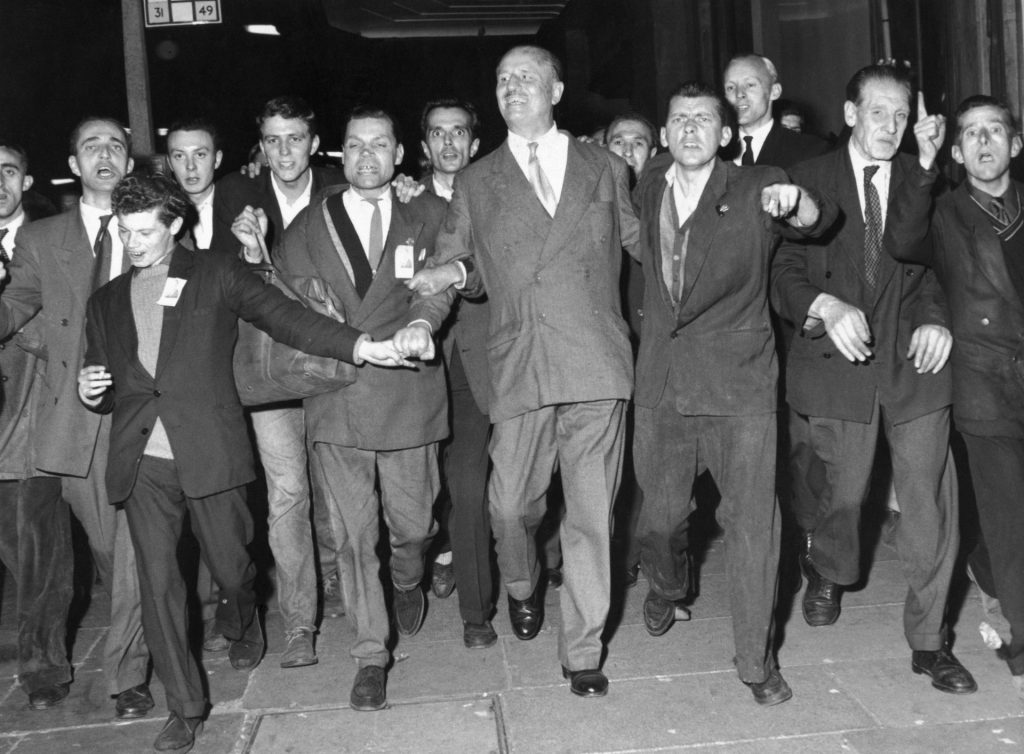
The year after the 1958 Notting Hill race riots he stood as a general election candidate in Kensington North, calling for the forced repatriation of Caribbean immigrants which would stop the “brothels, vice clubs and all-night parties” and a prohibition of mixed-race marriages.
In his election leaflets Mosley also told voters that British membership of a united Europe would bring a number of advantages. Wages would be higher as a united Europe would be free from undercutting, while prices would be low due to mass production. Mosley also claimed that if Europe united, the USSR would offer to withdraw from the east of the continent.
Mosley argued that the “white dominions can enter the European economic system with us” due to the potential combined trading power. However, he made it clear that “the black colonies cannot fit into a united Europe because they are a different people with a different standard and way of life”.
Across western Europe, Mosley worked with other Far Right groups towards the goal of a united Europe. In Venice in 1962 he formed the National Party of Europe with the Belgian Mouvement d’Action Civique, Italian Social Movement and West German Deutsche Reichspartei, based around his pan-European vision.
However, by then it was clear this was not a vision that was widely shared among the general population or even, particularly, on the far right, and it struggled to gain a foothold at home and abroad.
Most European far-right parties ultimately preferred to maintain and promote their own distinct national character, as did many British fascists. Mosley’s “Europe a nation” policy alienated many on the UK’s extreme right, where his influence waned. Many were drawn instead to the League of Empire Loyalists, led by former BUF man Arthur K Chesterton, which was more concerned with preserving the British Empire than constructing a union with other European states.
As Mosley himself became disillusioned and drifted into exile in Ireland and later France, his vision of a far-right united Europe drifted into history.
Although itself a tiny organisation, it was the League of Empire Loyalists and its concept of “Britain (and its empire) first” that became the dominant strain in British fascism. There was little overlap with the idea of pan-Europeanism in its outlook.
Far-right politics from the late 1960s and into the 1970s was dominated by the Eurosceptic National Front – which was created from the League of Empire Loyalists and similar groups, on the initiative of Chesterton and others – who claimed that the European Economic Community was a threat to British sovereignty and part of a Jewish conspiracy for a one-world government.
They campaigned for a “no” vote in the 1975 EEC referendum. This position was enhanced by the anti-immigration and Eurosceptism of Enoch Powell, as opposition to the EEC became the norm on the far right.
When the BNP replaced the NF as the main force on the far right in the early 1980s they also took a Eurosceptic stance, based upon the Powellist sovereignty argument.
However, Thatcherism moved such arguments into the mainstream right by the late 1980s with this respectability allowing the emergence of UKIP and Nigel Farage – and arguably leading to Brexit.
Ultimately, Mosley’s vision failed to capture the support of the Far Right or establish the legacy or influence of Powell or Farage.
His pan-Europeanism, unlike the sovereignty-based Powellism and anti-immigration perspective of the BNP and UKIP, sounds frozen in time, with its emphasis on European independence from the USA and the USSR, apartheid in South Africa and corporatism.
Within the perceived threat from communism in Eastern Europe the EEC was transformed into the EU much to the chagrin of British Eurosceptics, with the main parties broadly switching positions on British membership.
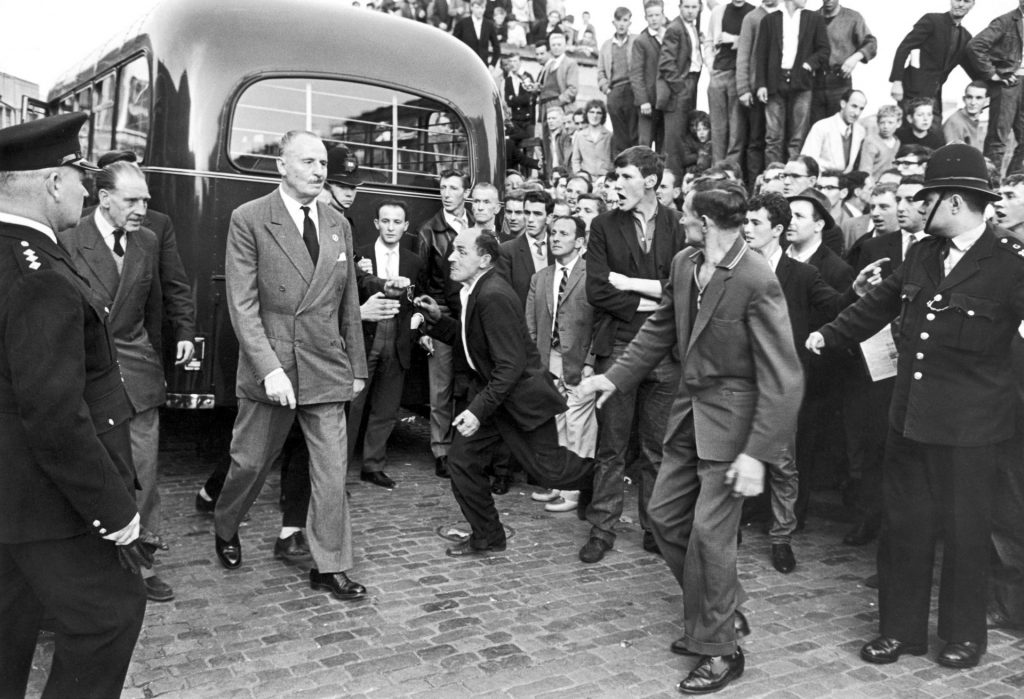
In a sense, much of Europe was united in a union, but not in the way Mosley envisioned or would have supported.
THE REAL RIDLEY ROAD RIOTERS
Mosley’s Union Movement was less of a street-based militant group than his pre-war Blackshirts had been. However, they were not averse to getting involved in violence.
The most notorious incident occurred on July 31, 1962, on Ridley Road, in Dalston, East London – and provided the inspiration for the recent BBC series named after the street.
On that day, the UM organised a rally there, with Mosley due to speak from the back of a lorry.
Several thousand protestors had gathered in the area and as soon as he appeared from between two police buses the crowd surged forward and Mosley was knocked to the ground.
He tried to fight back from the cobbles, before police helped him to climb on to the lorry prepared for his address.
Mosley was met by a hail of missiles including rotten fruit, pennies and stones and people tried to storm the platform.
His speech was drowned out by continuous boos and a chorus of “down with the fascists”.
Police were forced to close the meeting within three minutes and made 54 arrests, among them Mosley’s son Max – later the boss of Formula 1 – who was subsequently acquitted of any charges.
Ridley Road was the thriving epicentre of the local Jewish community and had long been a favourite meeting place for Mosley and his fascists.
It had been the scene of another violent confrontation between fascists and protestors on June 1, 1947 – the so-called Battle of Ridley Road.
On that occasion, the 43 Group, a “direct action” organisation set up by ex-Jewish servicemen in 1946, broke up a meeting by the far-right British League, one of the constituent groups of the Union Movement, which was established the following year.

